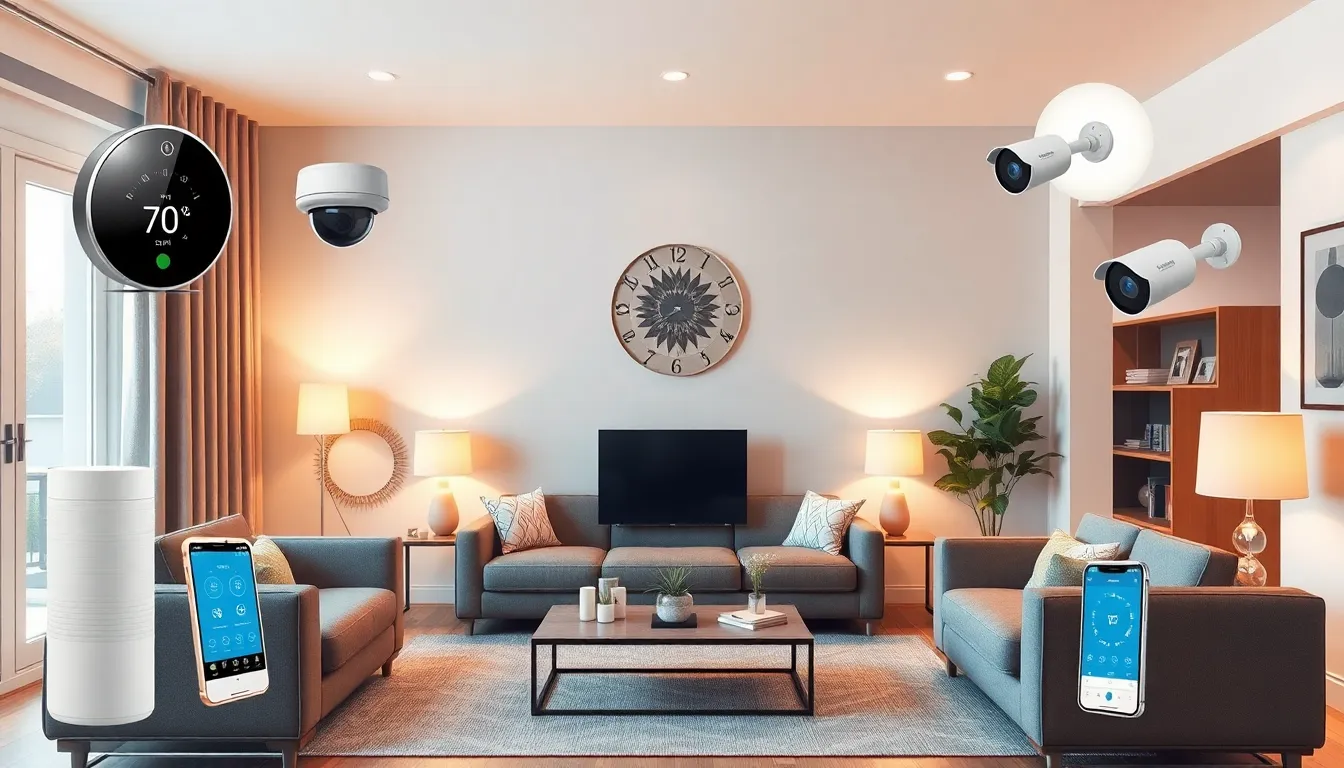In a world where your toaster might be plotting against you, securing smart home devices is no longer optional—it’s essential. As technology makes life easier, it also opens the door to potential intruders who could turn your cozy abode into a digital playground. Imagine a hacker turning your smart fridge into a late-night snack dispenser, leaving you with a mountain of empty pizza boxes and a hefty bill.
Table of Contents
ToggleUnderstanding Smart Home Security
Securing smart home devices is essential due to rising cyber threats. Increased reliance on technology means vulnerabilities must get addressed.
Importance of Securing Smart Devices
Securing smart devices protects personal data and privacy. Cybercriminals exploit weak networks to access sensitive information. According to a study, 57% of smart device users faced security breaches. Unauthorized access can lead to identity theft or financial losses. Keeping devices secure also maintains their functionality and reliability. Each device, from smart locks to cameras, contributes to home security. If compromised, the entire system becomes susceptible. Creating robust security measures fosters trust in smart home technologies.
Common Threats to Smart Home Devices
Common threats include hacking, phishing, and malware attacks. Hackers often target unprotected networks to control devices remotely. Phishing schemes deceive users into revealing sensitive information. Malware can infiltrate systems through unsecured connections, causing damage. DDoS attacks can overwhelm smart devices, disrupting connectivity. Additionally, poorly configured settings create easy entry points for attacks. Maintaining software updates mitigates these risks effectively. Awareness of these threats empowers users to implement stronger defenses and safeguard their living environment.
Best Practices for Securing Smart Home Devices

Securing smart home devices involves adopting specific practices that enhance protection against cyber threats. Consider the following recommendations to improve device security.
Change Default Passwords
Changing default passwords proves critical in securing smart home devices. Most manufacturers set factory passwords that are easy to guess. Users must select complex, unique passwords instead. Implementing a combination of uppercase letters, lowercase letters, numbers, and symbols enhances security significantly. Regularly updating these passwords helps maintain protection against unauthorized access. Avoid using the same password across multiple devices to strengthen security further.
Enable Two-Factor Authentication
Enabling two-factor authentication adds an essential layer of security. This process requires users to verify their identity through a secondary method after entering a password. Various authentication methods include text messages, email codes, or authentication apps. Utilizing two-factor authentication can drastically reduce the likelihood of unauthorized access, even if credentials face compromise. Many smart devices support this feature, making it accessible to users seeking enhanced security.
Keep Software Updated
Keeping software updated is vital for maintaining optimal security. Manufacturers regularly release updates that address vulnerabilities and improve performance. Users must enable automatic updates whenever possible to ensure timely installations. Maintaining awareness of news regarding software updates helps users apply new patches manually if necessary. Device security often relies on the latest software, as updates frequently combat emerging threats effectively. Staying proactive in this area minimizes potential risks significantly.
Network Security Tips
Securing your home network enhances the protection of smart devices against cyber threats. Following specific guidelines ensures reliable and safe connectivity.
Secure Your Wi-Fi Network
Protecting the Wi-Fi network forms the backbone of smart home security. Change the default router settings, such as usernames and passwords, to unique alternatives. Utilize strong encryption protocols like WPA3 to secure the network. Regularly update router firmware to patch security vulnerabilities. Additionally, monitor connected devices to detect unauthorized access quickly. Implementing these measures significantly minimizes the risk of intrusions, given that 57% of smart device users experienced breaches due to weak networks.
Use a Guest Network for Guests
Creating a guest network for visitors separates personal devices from external connections. A distinct network for guests prevents potential access to sensitive information stored on smart devices. Disable shared access to your primary network, ensuring guests only connect to the guest Wi-Fi. Limit guest access duration and bandwidth to maintain control. Each of these steps adds an extra barrier against unauthorized access, helping to preserve the integrity of your smart home environment.
Regular Monitoring and Maintenance
Regular monitoring and maintenance of smart home devices plays a vital role in enhancing security. Users should prioritize ongoing vigilance to protect their technology.
Regularly Check Device Permissions
Reviewing device permissions periodically ensures only necessary access remains. Devices may request permissions to individual accounts or systems during setup. Users may unknowingly grant permissions that compromise security. Adjusting or revoking unnecessary permissions strengthens the overall defense. Smart devices often provide options within their respective apps to facilitate these changes. Regular checks prevent unauthorized access and help maintain control over personal data.
Monitor for Unusual Activity
Keeping an eye on devices for unusual activity can help identify potential threats early. Users should assess device activity logs to spot any unfamiliar access. Changes in behavior or unexpected alerts from devices often signal possible breaches. Recognizing irregular patterns allows users to act swiftly, enhancing their response strategy. Strengthening the home network can also mitigate risks by limiting external intrusion opportunities. Regular monitoring of devices contributes to a more robust smart home security framework.
Securing smart home devices is no longer optional; it’s essential for protecting personal data and maintaining a safe living environment. By implementing best practices like changing default passwords and enabling two-factor authentication, users can significantly enhance their defenses against cyber threats.
Regular monitoring and maintenance of devices further contribute to a robust security framework. Staying informed about potential risks and adopting proactive measures ensures that smart technologies continue to provide convenience without compromising safety. Embracing these strategies empowers individuals to enjoy their smart homes with peace of mind.




